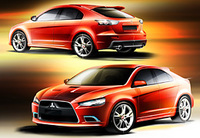2008 Geneva Motor Show: Mitsubishi to Show Prototype-S Sports Hatchback Concept
TOKYO - January 28, 2008: Mitsubishi is to give the Prototype-S concept its global debut at the 78th Geneva International Motor Show which runs from March 4 through March 16 at the Geneva Palexpo exhibition and conference complex (opening to the general public on March 6.)
Deriving from MMC's sport sedan family, which includes the Lancer (named the Galant Fortis on the Japanese market) launched in 2007 and the Lancer Ralliart announced at the 2008 Detroit Motors Show and the Lancer Evolution (Lancer Evolution X in Japan) premiered at the 2007 Tokyo Motor Show, Prototype-S takes the form of a hatchback — a very popular body type in European markets.
Distinguished by the inverted-slant nose with trapezoidal grille front fascia that marks Mitsubishi Motors new design identity and with wide-and-low proportions that leave no doubt as to the concept underlying its design, Prototype-S uses exterior lines to craft a shape that is powerful and sporty even by European standards, echoing the acclaimed 2005 Concept-Sportback show car.
In its mechanical specification Prototype-S is powered by a 2.0-liter 4-cylinder DOHC MIVEC*1 intercooler / turbocharger engine [developing maxima of 177 kW (240 PS) and 343 Nm (35 kg-m)] mated to Mitsubishi Motors's high-efficiency Twin Clutch SST automated manual transmission that marries fun-to-drive control with outstanding fuel efficiency. The full-time 4WD driveline features Mitsubishi Motors' Active Center Differential (ACD) that uses an electronically controlled multi-plate hydraulic clutch to optimally tailor front/rear drive torque split to different driving conditions and deliver the best balance between steering response and traction.
*1 MIVEC : Mitsubishi Innovative Valve timing Electronic Control System



